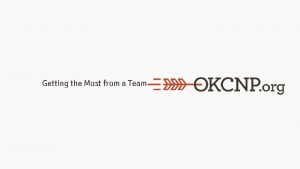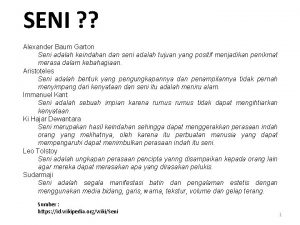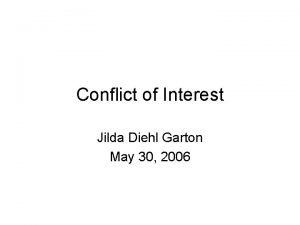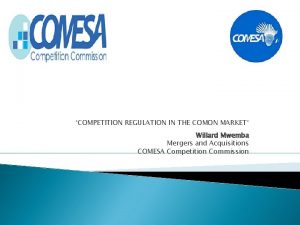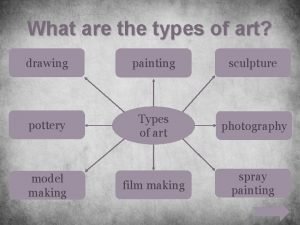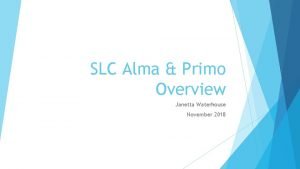Online Safety Janetta Garton Technology Curriculum Director Willard









- Slides: 9

Online Safety Janetta Garton Technology Curriculum Director Willard R-II School District http: //www. willard. k 12. mo. us/co/tech/safety. htm

District Policy that must be signed by students, parents, and staff prior to gaining access to the school’s network and the Internet. Unfortunately, to be legally binding, these policies often are written in a language unfamiliar to students. It is important to discuss this policy with your students in terms they can understand. Image Credit: School Rules by Zac-Attack

Image Credit: Alleke by kellyandapril

Access to Inappropriate Content We do have a district filter. This software is used to strain out inappropriate sites. However, you cannot depend solely on this filter to insure that your students are visiting only appropriate web sites. Inappropriate content could be: hate sites that promote delinquency (weapons, drugs, fake ids, explosives) pornography sites gambling sites Gates to Inappropriate Content advertisements: click the blinking banner searching: inappropriate sites appear in the search results typo squatting: a site’s url uses a misspelling of an appropriate sites (funbrain. com & funbrian. com) or slight variation (whitehouse. gov & whitehouse. com) Image Kintana by Matt & Helen Hamm spam Credit: messages

Internet Offenders manipulate young people into criminal sexual relationships by appealing to young people’s desire to be appreciated, understood, take risks, and find out about sex. Predators will: use chat rooms look at profiles targeting kids who are looking for attention, don’t have much attention from parent’s at home, and parents that aren’t too tech savy try to get as much personal information as possible send an invitation to a private chat want to move on to email and phone work toward a face to face meeting establish a common ground by pretending to like the same things (music, movies, hobbies, sports, etc) work to build trust by showing interest in everything discussed in chat, agreeing always with child’s opinions and viewpoints may pose as a sponsor to recruit individuals for a competition, event, club, etc discourage discussing this relationship with anyone start introducing sexual content Signs that may a child be involved with predator: watch for diminished communication about what they are doing online 2366008863_2 edb 503 a 94_o by Darth. Abraham minimizing of. Image screen. Credit: when you approach unexplained phone calls or absences

Cyberbullying use of technology to spread rumors and gossip post pictures of someone without their consent steal passwords to assume someone else’s identity disseminate private information and threaten or harass with offensive language Cyberthreats or “distressing material” statements that make it sound like the writer is emotionally upset and may be considering harming someone else, or him/herself. Schools place restrictions on student speech that appears to be sponsored by the school, or that is necessary to maintain an appropriate school climate. This applies to student speech through the district Internet system or via cell phones used at school. For online speech posted when off-campus, there must be a substantial and material threat of disruption on campus. Law enforcement officials should be contacted when the situation involves: Making threats of violence to people or their property. Engaging in coercion obscene or harassing calls/messages Harassment or stalking. Hate or bias crimes Creating or sending sexually explicit images Sexual exploitation. Taking a photo of someone in place where privacy is expected (like a locker room) Addressing Cyber Bullying and Threats Safe School Committee Needs Assessment Policy & Practice Professional Development Parent/Community Education Student Education See the 2 flowcharts in the handout: Cyberbullying or Cyberthreat Situation Review Process & School Actions and Options Image Credit: Predator & Alien by Maigh

Intellectual property refers to creations of the mind such as: musical, literary, and artistic work; inventions; and symbols, names, images, and designs. The holder of this property has certain exclusive rights, copyright, which is automatic upon creation. Just because something is online doesn’t mean it’s legal to copy, download, or use. Piracy is the unauthorized use of material which is covered by copyright law Piracy causes economic harm to the copyright holders. Plagiarism Copying and pasting text from on-line Transcribing text Using photographs, video or audio without permission or acknowledgment Using another person's work and claiming it as your own, even with permission Acquiring work from commercial sources Translation from one language to another Using an essay that you wrote for another class/another purpose without getting permission from the teacher/professor of both the current class and the class for which the original work was used Peer to Peer Network uses connectivity and the cumulative bandwidth of participants in a network, as opposed to servers providing the service. Some illegally distribute copyrighted materials. Virus, spyware, and pornography are also available Often these files are labeled so as to attract students to download them. Users of the site can be held accountable for copyright infringement. Image Credit: Shhh, It Be the Little Lass' Treasure I Be Steal'n by Cayusa

Malicious code software created to cause damage, steal information, or use up resources on a computer or a network. Viruses programs that alter the way a computer operates without the permission or knowledge of the user. can impair and seriously damage your computer (or network server) by executing random text, audio and video messages; draining memory; deleting files; corrupting programs; erasing the contents of your hard disk. Worms replicate themselves without the use a host file. can overload networks and shut down communication Trojan Horses imposter files that claim to be something desirable to spread, you must open email attachment or a downloaded file Spyware hide on your computer to steal information such as credit card numbers, email addresses, home addresses, and surfing habits majority of it is adware, designed to capture “anonymous” data for targeted advertising. usually just an annoyance often bundled in other software that you install, but can also be acquired by simply accessing a webpage. Signs of Spyware You receive more pop-ups than usual. Your computer runs slowly. Icons appear on your desktop or task bar. Your default browser is changed. You hear your hard drive running even when you are not using the computer. Firewalls, anti-virus, and anti-spyware software address these issues. Keeping your operating system and other software up-to-date, and setting your browser’s security settings to medium or higher is important. Image Credit: Credit Card Theft by d 70 focus

Identity Theft theft of personal identifying information (name, address, credit card number, social security number) and use of that data to open new charge accounts, order merchandise, or borrow money. Phishing seemingly credible e-mail/text message/popup that I nstructs the user to visit a Web site where they are prompted to enter or update their personal information May say your account has come under review, may be in danger of being suspended and/or cancelled, and some piece of information needs to be verified or updated. often contain spelling or grammar errors. Contact your merchant right away to ask for clarification Spoofing appears to have been sent from one source when it actually was sent from another Any replies go legitimate e-mail account, not the real sender. Legitimate user can find their Inbox bombarded with viruses, bounced e-mail, and in some cases can have their account suspended for violating its anti-spam policy. Send a copy of the spoofed e-mail to the spoofed e-mail sender's ISP. Spamming unsolicited or undesired bulk messages district has a spam filter e. PALs there is a spam control setting that teachers can calibrate Willard Tiger Webmail has a Spam filter that you can activiate Shopping Online time saving convenience Helpful consumer reviews can put you at risk Image Credit: Identity Thief as Paris by Carbon. NYC
